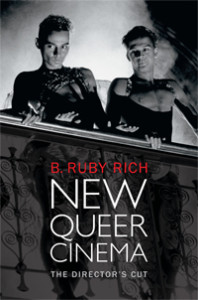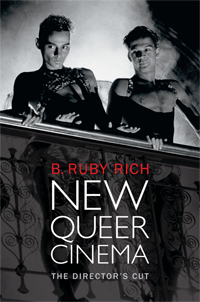 New Queer Cinema: The Director’s Cut
New Queer Cinema: The Director’s Cut
by B. Ruby Rich
Duke University Press
WHEN FILM CRITIC B. Ruby Rich penned an essay on the state of queer representations on the big screen in a 1992 Village Voice review, she managed to tap into the Zeitgeist perfectly. The article, which reflected on what she rightly saw as a new strain of angry, take-no-prisoners filmmaking informed by the AIDS crisis and decidedly not “Hollywood,” was reprinted in the British journal Sight and Sound under the headline “The New Queer Cinema,” and a movement had been defined and named.
Rich quickly became celebrated for coining the phrase, and she continued to write about how the burgeoning queer cinema movement would evolve. She identified several key elements in the films she was seeing—both shorts and feature-length—on the festival circuit. Films like Tom Kalin’s Swoon, Derek Jarman’s Edward II, and Todd Haynes’ Poison had certain things in common, in particular an utter disdain for the very notion of trying to appease mainstream audiences with pleasing images of gay people. Kalin, in particular, had reworked the legendary gay child killers Leopold and Loeb into his own stunning black-and-white fable. Gone from the NQC was any hint of Vito Russo’s plea for positive portrayals in The Celluloid Closet. Rich is correct when she says that these films could be so raw because there was such a sense of apocalyptic desperation at the height of the AIDS crisis. As she points out in her introduction, almost worse than the epidemic itself was the gleeful response of a huge number of people on the Right, who saw HIV as a form of no-fault genocide. Was it any wonder that marginalized queer filmmakers were furious?

Rich’s writing style is for the most part pleasantly readable as she alternates between essays that appeared in academic journals and more mainstream periodicals. Not confining herself to Hollywood and European cinema, Rich also includes far-reaching meditations on queer representations in South American cinema. She takes GLBT audiences to task for being too risk-averse and flocking to safer, gentler representations of gay characters. And there’s a lovely article on Forbidden Love, a brilliant but criminally neglected 1992 documentary in which several older women discuss what it was like to live as lesbians in the 1950s and ’60s. (The film, commissioned by Canada’s National Film Board, is not out on DVD due to copyright issues.)
Rich’s anthology is undoubtedly essential reading for GLBT cinephiles. For younger film students (straight, gay, or questioning) it sets the historical scene impeccably. For those of us who were there—and I was working as a film critic and graduate student through much of the period Rich writes about—this book creates a bizarre sense of nostalgia. So much of the ’90s was such a horrific time for us, as vast numbers of people died in a culture that appeared either indifferent or happy about the carnage. And yet, as Rich makes crystal clear, fury can be fertile ground for fantastic art. Reading this book reminded me of the strange sensation I got while watching the recent rash of documentaries about the AIDS crisis (Vito, We Were Here, United in Anger and the Oscar-nominated How to Survive a Plague): anguish at the losses and longing for the bonding and solidarity that the war efforts created.
That time is over. The AIDS crisis has changed dramatically, and the market conditions that allowed for the emergence of the New Queer Cinema are now gone. Distributors like Miramax that learned they could make money from small, independent films have mainly been shut down, now that those films are usually no longer profitable. And many of the filmmakers whose work Rich analyzes—including Haynes, Rose Troche, Jeremy Podeswa, and Laurie Lynd—have migrated to television. Does a vibrant queer cinema still exist? Well, they don’t make ’em like they used to.
Which points to one nagging question regarding New Queer Cinema: The Director’s Cut: where is Rich’s analysis of the impact of these images on the small screen? She does make mention of various TV shows with gay or lesbian characters, but I was left longing for her take on The L Word, or the queer moments in Glee, Six Feet Under, and even The Sopranos. Since so much of the best screenwriting is now on television, the time for old-school snobbery about the medium is over. Perhaps a sequel to this volume is in order.
Matthew Hays, author of The View from Here: Conversations with Gay and Lesbian Filmmakers, teaches film studies at Concordia University.





